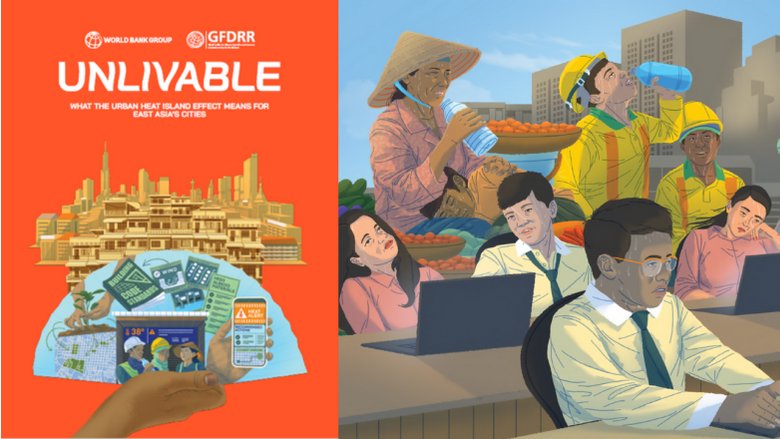
The urban heat island (UHI) effect, especially when considered together with climate change, represents a serious and growing threat to the competitiveness, livability, and inclusiveness of East Asia’s cities. However, because it is a local effect, the leaders of these cities can significantly mitigate its impact on local temperatures while also further promoting greater adaptation to extreme urban temperatures. This World Bank report addresses three critical questions:
How strong is the UHI effect in East Asia, and how is it interacting with climate change?
Why should policy makers worry about the UHI effect and extreme urban temperatures more generally?
What can city leaders do to combat extreme urban heat?
How strong is the urban heat island effect?
On average, East Asian cities are 1.6–2.0 degrees Celsius (°C) warmer than their immediate rural surroundings. Based on analysis of satellite data for 100 East Asian cities, land surface temperatures from 2016 to 2020 were, on average, 1.6°C warmer in these cities than in rural areas within 2 kilometers and 2.0°C warmer than in rural areas within 10 kilometers. Cities in Indonesia, Malaysia, and the Philippines—where average temperatures can be up to 5.9°C warmer—suffer from the strongest UHI effects.
UHI effects are much stronger than these averages in some neighborhoods and are strongest at night. The averages mask considerable variation in the strength of the UHI effect within cities. For example, new research for this report shows that in Bandung, Indonesia, there are heat disparities of up to 7.0°C between the hottest and coolest neighborhoods. Such thermal disparities between neighborhoods are typical of many cities, both in East Asia and globally. The UHI effect is typically stronger at night than during the day because the heat stored in the built environment is gradually released after sunset.
The UHI effect is often stronger in poorer neighborhoods. Within cities, a neighborhood’s UHI effect is often, but not always, strongly positively correlated with its poverty rate. Stronger UHI effects in poorer neighborhoods result from a relative lack of urban greenery and a greater prevalence of impervious surface areas.
The UHI effect is a particular concern for tropical East Asian cities where humidity adds to the risk of overheating. These cities already have hot and humid baseline climates that are, furthermore, becoming even hotter and more humid over time because of climate change. For example, in Phnom Penh, Cambodia, the UHI effect already contributes to 23–25 heat wave days a year in the city’s central districts. Fast forward to 2050, and the number of heat wave days a year is projected to more than double for those neighborhoods that have the strongest UHI effects.
Why worry?
Extreme urban heat damages competitiveness. For the world’s largest cities, literature indicates that productivity losses from the combination of the UHI effect and global warming will decrease real gross domestic product (GDP) by 1.4–1.7 percent for the median city by 2050. For the worst-affected city, the loss could reach almost 11 percent by the end of the century. New evidence presented in this report also shows that large Southeast Asian metropolitan cities and other East Asian cities with warmer baseline climates suffer significant losses in economic activity during extreme heat events.
Extreme urban heat hurts health. Already more than 100,000 people in the East Asia and Pacific region die each year owing to causes linked to extreme heat. And projections indicate that future warming during this century will increase heat-related mortality more than it decreases cold-related mortality.
Extreme urban heat makes cities less livable. This occurs both directly through the unpleasantness of extreme heat—especially when combined with high humidity—and indirectly through other negative impacts, such as potential increases in crime, violence, and car accidents.
What can be done?
To address the extreme urban heat challenge, East Asia’s city leaders can adopt a “Places, People, Institutions” policy framework. Heat stress is experienced in the physical spaces of a city. Making streets, plazas, parks, factories, workshops, marketplaces, and homes cooler will reduce heat stress, contributing to a vibrant economy and healthy population. But heat waves are also time-bound emergencies that endanger elderly people, children, exposed workers, and people with health vulnerabilities. Understanding who is at risk and providing them with information, health care resources, and respite from extreme heat is crucial to save lives during heatwaves. Extreme heat is also a challenge that requires coordinated action across city government institutions working in tandem with local stakeholders such as employers and neighborhood associations. Accordingly, this report proposes a policy framework based around three principles: cool the physical spaces of a city (“Places”), act during heatwaves to prevent death and illness among vulnerable populations (“People”), and mainstream heat resilience into city strategies, operations, and budgets (“Institutions”).
Actions in six priority areas can help city leaders deliver on a “Places, People, Institutions” agenda for heat resilience. These strategic options for action are (a) promote urban greening through strategic planning; (b) cool city spaces through wind, shade, and urban design; (c) engage building owners in tackling indoor heat; (d) save lives through heat wave early warnings; (e) protect heat-exposed workers; and (f) mainstream heat risk reduction throughout city institutions and strategies.